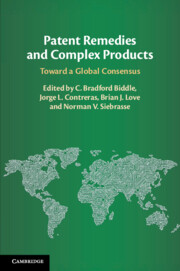Patent systems are designed to provide incentives to innovate by temporarily protecting the intellectual property to which those innovations give rise. While not always perfectly calibrated, most patent systems historically have accomplished that goal. But as the nature of innovation has changed over the years, patent systems have struggled to adapt to those changes. Legal principles that were once quite good at striking a balance between too much patent protection and too little when applied to simple patented technology are less pertinent in our modern world of increasingly complex technology. We no longer live in a world of simple inventions where the patented technology provides most, if not all, of the value of an end product. We no longer live in a world where reasonable royalties for past infringement are readily calculable or where an injunction against ongoing infringement almost always makes sense.
We now live in a world of complex technology – computers operating with sophisticated software, smartphones and similar multifunction devices, interactive televisions, autonomous vehicles, virtual reality, and the “Internet of Things.” Such complex technology creates complexities of a different sort for patent systems. A single end product (or even a single component of an end product) may contain multiple patented technologies, sometimes exponentially more than traditional machines or products. The law of patent remedies was crafted for simpler inventions; it does not neatly address the realities of current innovation.
Determining how our concepts of injunctions, reasonable royalties, lost profits, and enhanced damages should be applied in this new era is challenging. This is particularly true when it comes to properly valuing individual contributing pieces of patented technology. Assessing the value added by a patented invention to complex technology is necessary, but far from easy. And these challenges are magnified by the interaction of those remedies derived from patent law with those stemming from competition and contract law, particularly those contracts that patent holders enter into in return for designation of their patent as a standard-essential patent.
Compounding these challenges is the fact that, while patent laws and their attendant remedial principles are national, technology sales and, thus, a desire to encourage innovation, are global. Individual systems for patent remedies tailored to complex technologies on a national basis thus seem inadequate and short-sighted. Imposing one country’s attempted solution on jurisdictions with different legal and economic traditions cannot be done, however. That is not the solution. Cross-fertilization of ideas presents an opportunity to search out best practices, which can then both be adopted and adapted as appropriate. Finding consensus on what those best practices are is no small task. Such an undertaking would require an international coalition of patent law and economic experts focused on harmonizing disparate patent systems while maintaining respect for each nation’s values and policy goals.
The International Patent Remedies for Complex Products (INPRECOMP) project – involving an impressive group of twenty scholars from distinguished academic institutions in eleven countries – is taking aim at rethinking patent enforcement systems on a global scale. This book is an ambitious attempt to wrestle with the intricacies of intellectual property protection around the world and to seek international consensus on issues affecting patent remedies in the context of complex products.
The INPRECOMP participants have approached their challenging task in a thoughtful manner that is both academically rigorous and practical. I have had the pleasure of watching the INPRECOMP project in action. In March 2017, the INPRECOMP group presented its ideas and proposals for possible international harmonization to a panel of judges and patent law practitioners. I had the privilege to be among those before whom the group tested its concepts and from whom the group sought feedback. The work of the INPRECOMP participants, now reflecting that very feedback, is set forth in this work. This book represents substantial thought and effort directed to an important but very challenging goal. Careful consideration of the group’s ideas will be edifying for judges, legislators, and practitioners alike, as patent disputes relating to complex technology become increasingly more international in scope.



